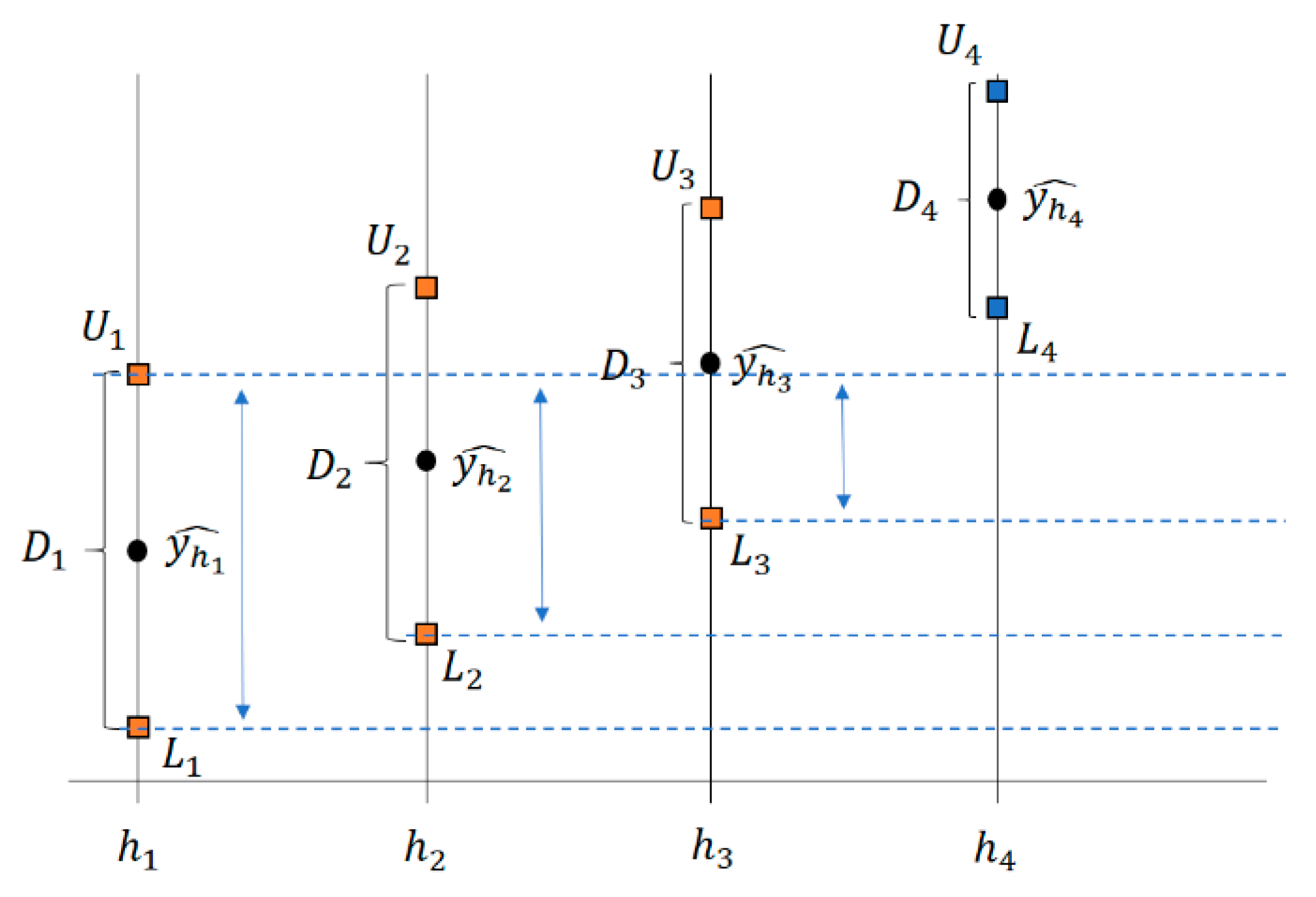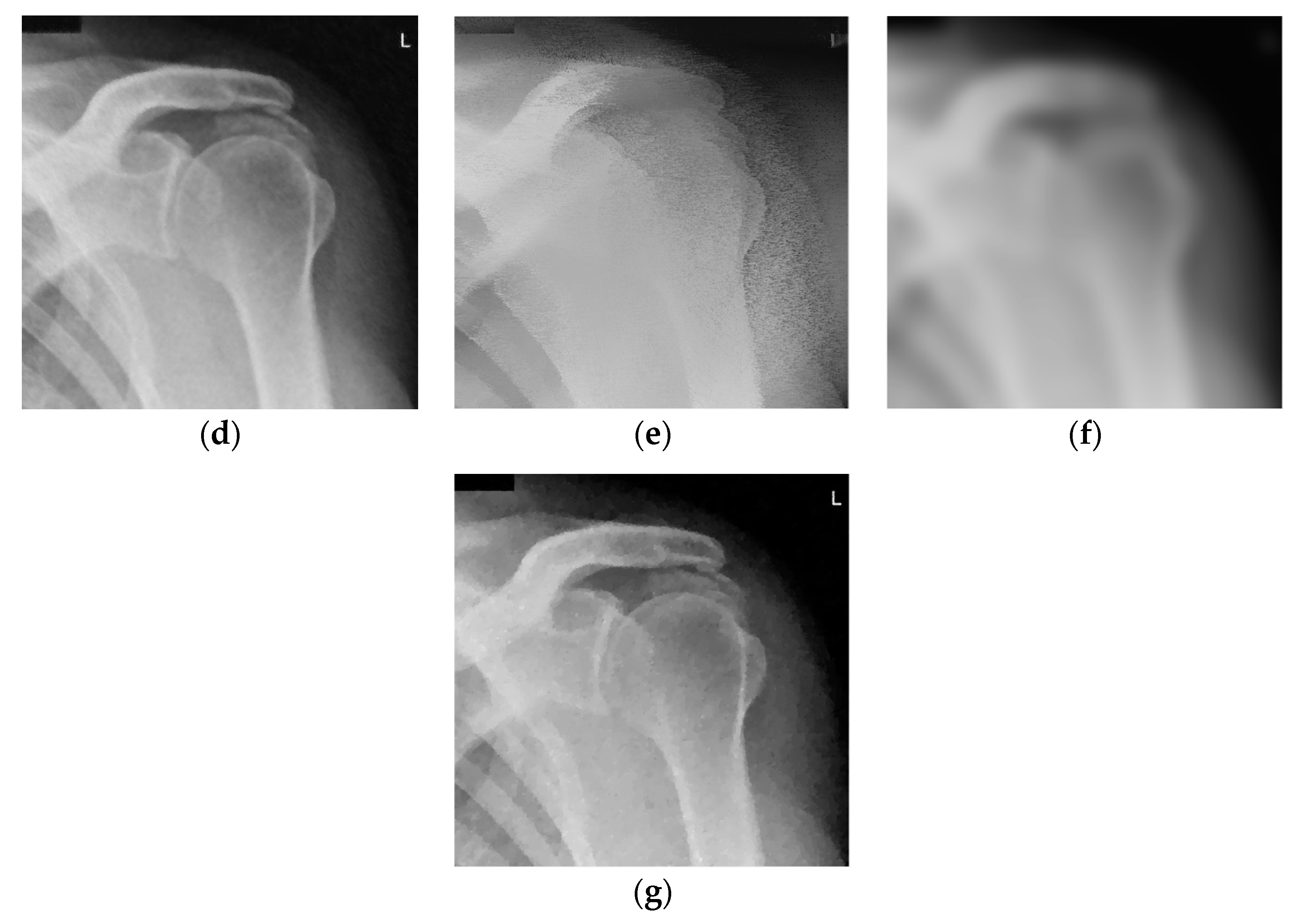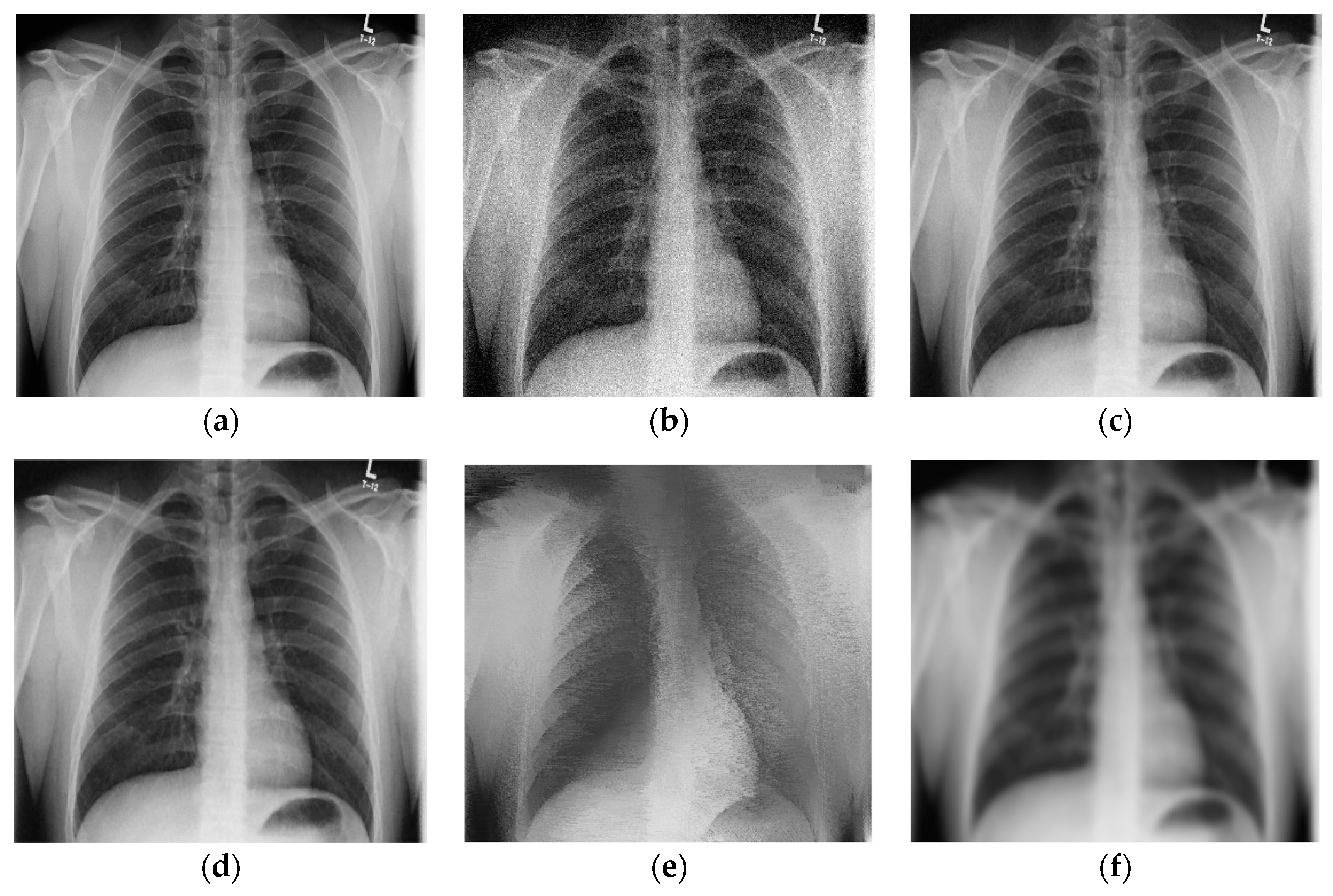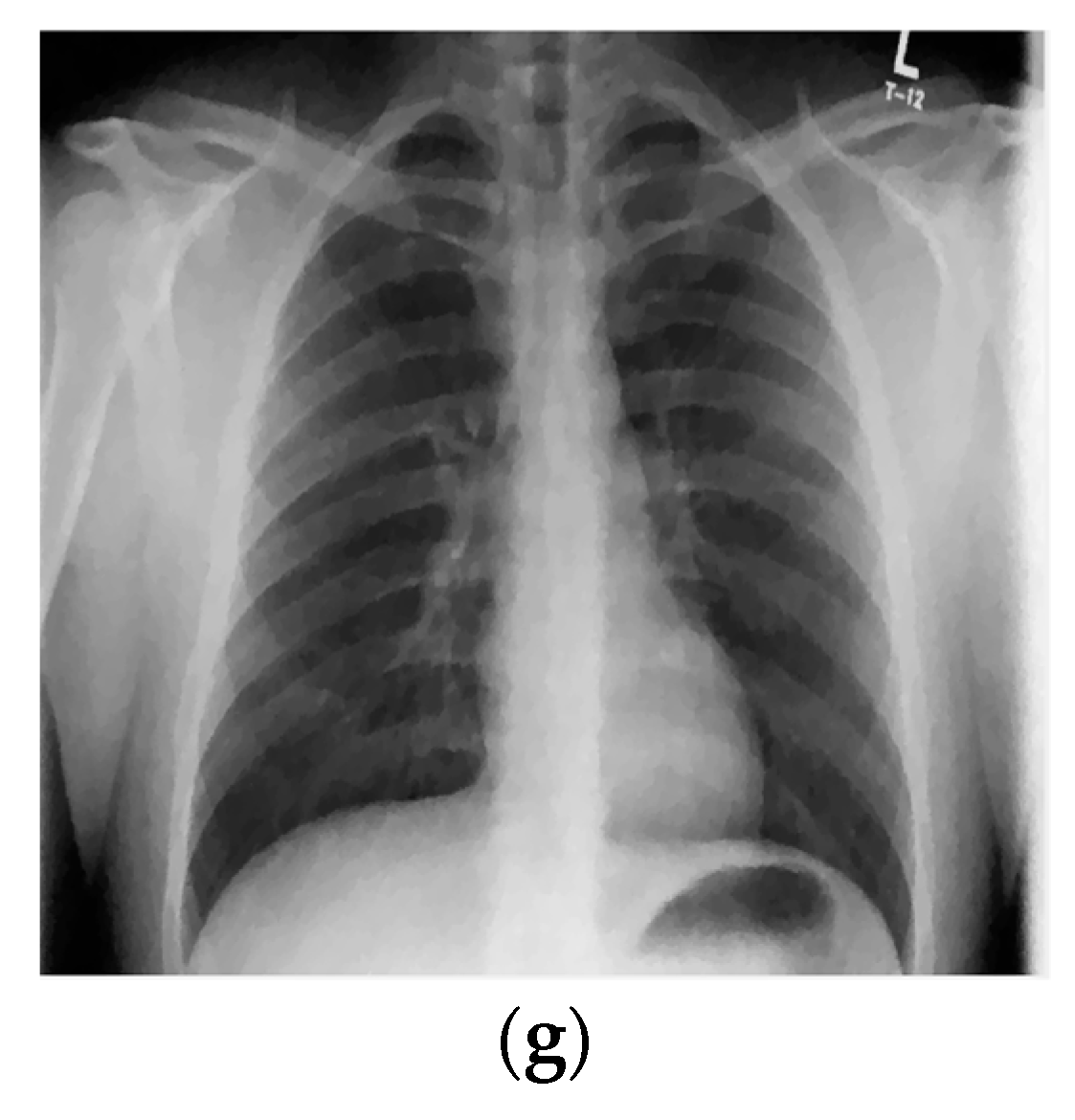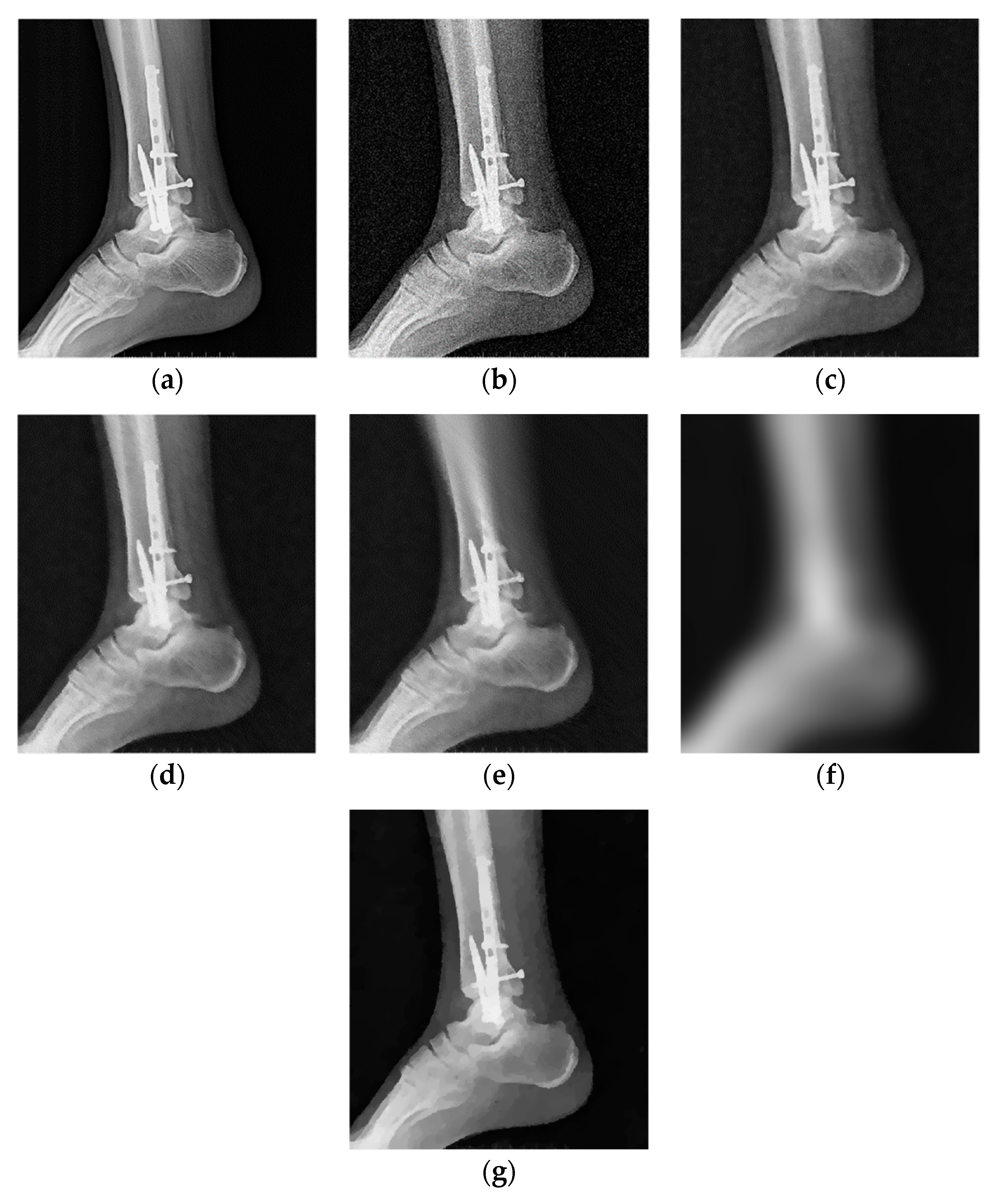1. Introduction
Denoising (both of one-dimensional and multi-dimensional signals) is one of the most important fields in signal processing and hence, the pursuit for novel and more efficient denoising methods is constant [
1]. Numerous methods developed over the last few decades found their applications in various fields, including medical image processing and analysis leading to enhancements in examining the interior of the human body without surgeries. However, since both revealing and treatment of large number of diseases today is highly dependent on medical images (such as computed tomography (CT), ultrasound, magnetic resonance imaging (MRI), X-rays etc.), improving their quality is an essential precondition for their analysis. One of the main problems with captured medical images is the presence of noise (introduced during both acquisition and transmission processes), which complicates their visual inspection and pathology pattern recognition. Thus, noise has to be suppressed in order to decrease the probability of possible misinterpretations and incorrect diagnoses [
2].
Due to their cost and a decrease in the dose of ionizing radiation, X-rays are still the most frequently used medical imaging technique. However, lower doses of radiation require more efficient noise reduction methods such that the important image features (object contours, edges, textures, etc.) are preserved while the noise is smoothed.
There are numerous techniques for reducing noise from medical images, which can be classified into two main categories. First are the methods for image processing in the spatial domain and the second are the transform domain filtering approaches [
3]. Spatial filtering methods may be divided into linear (such as, for example, mean and Wiener based filtering) and non-linear methods (for example, median and weighted median based filtering) [
3]. However, the linear spatial domain filtering fails in case of signal dependent noise and, unfortunately, it also introduces blurring artefacts to denoised images [
4,
5]. On the other hand, transform domain image processing approaches may be divided into data adaptive methods (for example, independent component analysis) and non-data adaptive methods (such as wavelet domain and spatial-frequency domain processing algorithms) [
3]. Unlike the spatial methods, the transform domain-based methods transform images from spatial into transform domain and noise is removed in the transform domain [
4]. Next, the estimate of the noise-free image is obtained by applying the inverse transform.
The method proposed in the paper introduces an algorithm for medical image processing based on the adaptive, data-adaptive 2D spatial filters designed using the local polynomial approximation (LPA) combined with the modification of the intersection of confidence intervals (ICI) rule, called the relative intersection of confidence intervals (RICI) rule (where RICI rule determines the size of the LPA estimators).
The 2D LPA-RICI based algorithm has been shown to be an efficient noise-free image estimator, since the RICI based algorithm calculates the near optimal estimator size and its 2D shape for each considered pixel [
6,
7]. Unlike the approaches based on the fixed size filters, the given method (due to its couture and edge preserving property) smoothes the noise locally in the vicinity of the considered pixel and hence avoids blurring artefacts in the resulting denoised images.
Once calculated, adaptive 2D regions are used as binary masks for segmentation and extraction of the regions of interest from the original image. The noise-free estimate of the considered pixel is found by applying the LPA weighted averaging to the extracted region. The described procedure is repeated independently for each image pixel separately. Thus, one of the important advantages of the proposed 2D LPA-RICI based image denoising algorithm is that it may be easily parallelized in order to improve the method’s computational efficiency.
The proposed adaptive 2D LPA-RICI method was applied to denoising of real-life medical X-ray images, outperforming competitive methods (Gaussian smoothing filters, total variation denoising and fixed size median filtering) in most cases.
The paper is organized as follows.
Section 2 introduces the original ICI rule and its modification (the RICI rule) extended to 2D image processing.
Section 3 gives an elaboration on the achieved results. The conclusion is found in
Section 4.
3. Results and Discussion
This section presents denoising results achieved using the proposed 2D LPA-RICI method applied to three test X-ray images (namely, X-ray scans of shoulder, chest and ankle). The method was implemented in the Matlab 2015b and denoising performances were measured in terms of the peak signal-to-noise ratio (PSNR).
Shoulder X-ray images (with resolution 1024 × 1018) are presented in
Figure 3. Namely, the noise-free image is given in
Figure 3a. The noisy image is shown in
Figure 3b (corrupted by additive white Gaussian noise (AWGN) the standard deviation of which is σ = 25).
Figure 3c–e present images denoised using the RICI based method. Namely,
Figure 3c is denoised using the quadrilateral regions,
Figure 3d is denoised using the octagonal regions and
Figure 3e is denoised using the hexadecagonal regions.
Denosing results, in terms of the PSNR, for the shoulder X-ray image are given in
Table 1 (for various Г and Rc values). The first column gives regions (octagonal, octagonal and hexadecagonal, respectively). The second and the third column present parameter values for the 2D LPA-RICI denoising method. The fourth column presents the standard deviation of the AWGN. The fifth column provides the noisy image PSNR followed by the column giving the PSNR for image denoised using the proposed RICI based method. The last three columns of the
Table 1 show the PSNRs of the images denoised using fixed size filtering (2D median filter), Gaussian smoothing filters and total variation denoising, respectively. For the Gaussian smoothing filtering a Matlab function imgaussfilt was used with standard deviation values chosen same as the standard deviations of the AWGN (σ = 20, 25 and 30). For the total variation denoising [
12] Matlab function provided at the MathWorks was used with parameter λ chosen as λ = 0.2, λ = 0.25 and λ = 0.3 for the three tested AWGN levels (σ = 20, 25 and 30), respectively.
Table 2 gives PSNR improvements obtained using the 2D LPA-RICI method vs. noisy image and images denoised using the fixed size filtering, Gaussian smoothing filters and total variation method, respectively. As shown in
Table 2, the proposed adaptive RICI based method outperforms the fixed size filters in all cases. Furthermore, it outperforms Gaussian smoothing filters and total variation denoising when quadrilateral and octagonal regions are used (hexadecagonal regions do not outperform Gaussian smoothing and total variation denoising methods).
Namely, the 2D LPA-RICI with quadrilateral regions increased the PSNR of the denoised image by up to 9.13 dB, with octagonal regions increased the PSNR by up to 10.50 dB and with hexadecagonal regions increased the PSNR by up to 4.69 dB (when compared to the noisy image). Also, the proposed 2D LPA-RICI method outperformed the fixed size 2D median filtering by up to 7.99 dB, the Gaussian smoothing filters by up to 6.08 dB and the total variation denoising by up to 4.35 dB for shoulder X-ray scan.
Denoising time for the fixed size filtering was up to 1 s and up to 3 s for the Gaussian smoothing filter and up to 7 min for the total variation denoising. However, the denoising time for the 2D LPA-RICI method without parallelization was up to 40 min for shoulder X-ray scan, depending on the used region. Namely, denoising time for quadrilateral region was up to 24 min, for octagonal region up to 34 min and for hexadecagonal region up to 40 min (greater number of polygonal angles leads to longer execution time).
Denoising of all test images was performed on a personal computer Dell Inspiron 15R 5521 with Intel processor i5 d generation, 6 GB RAM DDR3, 1 TB HDD SATA 1.5 Gbps and Windows 8.1 (64-bit) operating system.
The results for the second test image (chest X-ray image with the resolution 2431 × 1782) are given in
Figure 4. Namely,
Figure 4a,b shows the noise-free and the noisy image (also corrupted with AWGN with σ = 25), respectively.
Figure 4c–e present denoised images obtained using the proposed 2D LPA-RICI algorithm with quadrilateral, octagonal and hexadecagonal regions, respectively.
The PSNR results for denoised chest X-ray images are found in
Table 3. As it can be seen from
Table 3, the proposed 2D LPA-RICI method (as it was the case for the shoulder X-ray image) outperformed fixed size 2D filtering in all cases. Furthermore, the RICI based denoising outperformed Gaussian smoothing filters and total variation denoising when quadrilateral and octagonal regions were used.
Table 4 gives PSNR improvements for chest X-ray scan denoised using the 2D LAP-RICI method compared to noisy images and images denoised using the fixed size filtering, Gaussian smoothing filters and the total variation method, respectively. Namely, the LPA-RICI method enhanced denoised image quality, both visually and in terms of the PSNR, by up to 9.40 dB when quadrilateral regions were used, by up to 10.23 dB when octagonal regions were used and by up to 5.25 dB when hexadecagonal regions were used (when compared to the noisy image PSNR). It also outperforms fixed size 2D median filtering in all cases, increasing the PSNR by up to 7.51 dB. In addition, the 2D LPA-RICI method outperformed the Gaussian smoothing filters by up to 5.35 dB when quadrilateral and octagonal regions were used. Furthermore, it also outperformed the total variation denoising increasing the PSNR by up to 3.30 dB (in case of the adaptive 2D quadrilateral and octagonal regions).
Denoising time for the chest X-ray scans for the fixed size filtering was up to 1.5 s and for the Gaussian smoothing filter up to 6 s. Furthermore, the denoising time for the total variation method was up to 10.5 min and for the 2D LPA-RICI without parallelization up to 60 min, depending on the used regions (up to 36 min for quadrilateral regions, up to 51 min for octagonal regions and up to 60 min for hexadecagonal regions).
Denoised ankle X-ray images (with resolution 600 × 682) are given in
Figure 5.
Figure 5a,b show noise-free and noisy images, respectively.
Figure 5c–e shows the denoised images obtained using the 2D LPA-RICI method with quadrilateral, octagonal and hexadecagonal regions, respectively.
Table 5 gives the PSNRs of the denoised ankle X-ray images. The proposed 2D LPA-RICI method, as it was the case for other two test images, outperformed fixed size 2D filtering in all cases. Furthermore, it also increased the denoised image PSNR when compared to the Gaussian smoothing filters and the total variation denoising (when quadrilateral or octagonal regions were used).
As it can be seen from
Table 6, ankle X-ray scan denoised by the 2D LPA-RICI method with quadrilateral regions resulted in an increased PSNR (compared to the noisy image) by up to 8.09 dB, by up to 7.46 dB with octagonal regions and by up to 3.93 dB with hexadecagonal regions. Once again, the proposed 2D LPA-RICI method was shown to significantly outperform the fixed size 2D median filtering. In addition, it also outperformed Gaussian smoothing filter method for all tested regions (including hexadecagonal regions, which was not the case in the previous examples) by up to 5.46 dB. Furthermore, it increased the denoised PSNR when compared to the total variation denoising method by up to 2.80 dB (when quadrilateral and octagonal regions were used).
Denoising of the ankle X-ray scan took by up to 0.5 s for fixed size filtering, by up to 2 s for the Gaussian smoothing filtering and by up to 5 min for the total variation denoising. Denoising using the LPA-RICI method without parallelization took up to 23 min (for quadrilateral region up to 15.5 min, for octagonal region up to 26 min and for hexadecagonal region up to 32 min).
The provided study showed that the proposed 2D LPA-RICI method performs competitively in terms of medical image denoising due to its adaptivity to image content and calculation of the 2D regions neighbouring the considered pixel for each pixel independently. Furthermore, it was shown that the proposed method outperforms fixed size filters for all tested cases (as shown in
Table 1,
Table 2,
Table 3,
Table 4,
Table 5 and
Table 6). Also, the proposed 2D LPA-RICI method outperforms Gaussian smoothing filters and total variation denoising when adaptive quadrilateral and octagonal regions were used. Furthermore, the obtained results suggest that increasing the number of polygonal angles does not necessarily result in improved estimation accuracy (quadrilateral and octagonal regions performed better than the hexadecagonal regions). However, a larger number of polygonal angles increases computational burden of the 2D LPA-RICI method, thus the study suggests using the 2D LPA-RICI with quadrilateral and octagonal regions in medical imaging applications.
Note also that greater improvements may be obtained in cases of higher resolution images (as it is case for images shown in
Figure 3 and
Figure 4 compared to the ankle X-ray image in
Figure 5).
In addition, since denoising of each image pixel is done independently, the method is applicable for easy parallelization which would reduce its computational expenses.
4. Conclusions
The paper introduces an adaptive denoising method applied to medical image denoising. The proposed method is based on a modification of the ICI algorithm, called the RICI algorithm, extended to local 2D LPA based filtering. The paper shows that the proposed 2D LPA-RICI method performs competitively in terms of medical image denoising due to its adaptivity to image content by readjusting the size and shape of 2D regions from pixel to pixel independently. Thus, the proposed method is easily parallelized for reducing its computational expenses.
The 2D LPA-RICI with quadrilateral, octagonal and hexadecagonal regions was tested in the paper, showing that increasing the number of polygonal angles does not necessarily result in an improved denoising accuracy. On the other hand, a larger number of polynomial angles increases the method’s computational burden.
The method was tested on real-life X-ray images and compared to the fixed size 2D median filtering, Gaussian smoothing filters and the total variation denoising. The 2D LPA-RICI method increased the image PSNR by up to 10.50 dB when compared to the noisy image PSNR. Furthermore, it outperformed the fixed size filtering by up to 7.99 dB, as well as the Gaussian smoothing filters when quadrilateral and octagonal regions were used by up to 6.08 dB. Furthermore, the 2D LPA-RICI method with quadrilateral and octagonal regions outperformed the total variation denoising by up to 4.35 dB.
